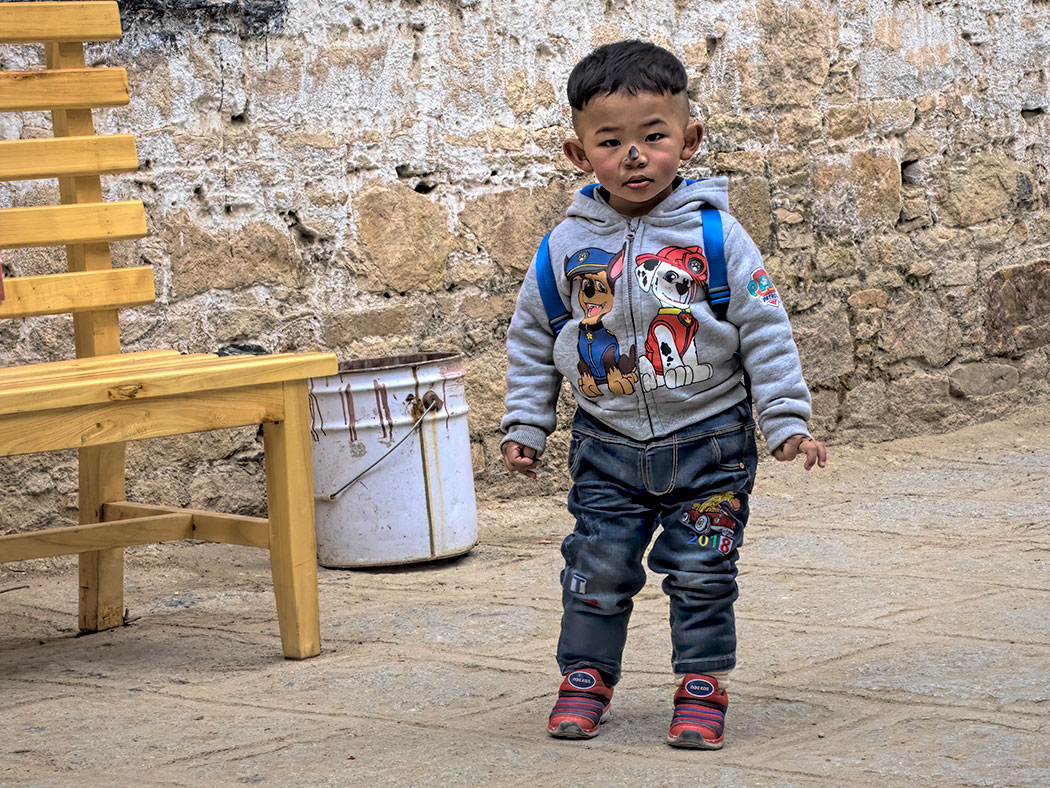All across Tibet, I spied kids with black marks on their noses, like this young boy at Sera Monastery in Lhasa. Our guide explained that in Tibetan Buddhism folk tradition, placing a smudge of soot on the nose of a child is believed to ensure good sleep and provide protection. Parents routinely bring their children to the monastery where monks apply the mark, using soot that has deposited on the walls from the long-term burning of butter lamps. I was curious about the “protection” part of the belief, so I did a little research.
The practice apparently derives from an ancient legend about two villages located on the opposite sides of a river. The village on one side of the river was filled with evil spirits who constantly sowed strife among the inhabitants. The village on the opposite side of the river, free of evil spirits, was a place of harmony. One day, two evil spirits crossed to the other side with a plan to sow dissent in the harmonious village. The first spirit would go to the home of a happy couple and make them argue. The second spirit would toss the woman and her child into the swiftly running water as they fled to her parent’s home on the other side of the river.
The couple did indeed have a horrendous argument and the woman snatched up her child to leave. Fortunately, she remembered that there were many evil spirits across the river, so she stopped long enough to smear soot from the bottom of her skillet on the child’s nose as a protection. She muttered a prayer as she crossed the bridge and returned to her parent’s home without incident. Later, the spirit who caused the argument asked his partner in crime if he had tossed the woman into the river. The spirit replied that the woman never appeared; the only thing he’d seen crossing the bridge was an iron skillet reciting a prayer.
This folkloric tradition in Tibetan Buddhism is still followed ritually. When a baby is one month old, it is taken out of the home for the very first time on an auspicious day. Before leaving, black ash from the bottom of a pot is smeared on the baby’s nose to ward off evil. Parents continue to apply the black soot throughout a child’s adolescent years, especially if a child is considered to be particularly attractive. It is believed that the mark distracts bad spirits, who might otherwise cause harm to a child that is perceived to be too beautiful.
Author’s note: Many thanks to Himalaya Journey, the small group tour company with whom I traveled. Not only did they provide an excellent tour, my guide was always ready with fascinating tidbits about Tibet and Tibetan Buddhism. If you enjoyed this story, you may also be interested in reading about my experience of climbing to the top of the Potala Palace in Lhasa.


Hello Barbara. Very beautiful photo. I am a tour operator, a tour guide and a mother in Lhasa. It is indeed very helpful for children specially in when they keeps on crying for no reason. In Tibetan we have a saying, since baby head skull is not very well develop. they are easy influence by negative energy of others Jealousy and backbites.
Hi Kalsang. Thanks for sharing that information. I am fascinated by cultural differences and love knowing what people believe in different parts of the world.
Great shot, and glad you did your research on it, Barbara. It is interesting to learn more about these different cultures, and why it still goes around till today. Most Asian cultures do have those protection from evil spirits and all, just that they are increasingly dying. If you happen to go to the textile museum in Malaysia, you’ll see that the ornaments worn by princess do have a slot for spells.
Travellers like you are rare nowadays. The youngs are more interested in shouting to the world that “I’ve been here. And I took great shots to prove it” via their IG accounts.
Awesome post Barbara!
Lela, you just made my day! Thank you for recognizing (and for taking the time to leave a comment) about how much research my writing requires. I am constantly bemoaning the quality and shallowness of online travel writing. Most of it falls into the category of “listicles” – lists of “top ten” or “best of” destinations, accommodations, and attractions. A lot of writers of listicles have never even been to those places, much less investigates the places they list. It’s all about chasing page one on Google searches. So few of us continue to write first person, narrative stories about places we actually visit. It’s comments like yours that keep me doing what I’m doing.
Barbara, this is fascinating! I so enjoy reading your abour your travels! Thanks for keep us non-travelers a glimpse at the rest of the world. XOXO
Morgan
Thanks so much Morgan. I hope you know that I truly value your continued support of my blog and stories!
Love your comments on Tibet young lady. It’s such an interesting country! Thanks for sharing.
Mike
Thanks so much Mike. It was a trip of a lifetime. If you get a chance, go!